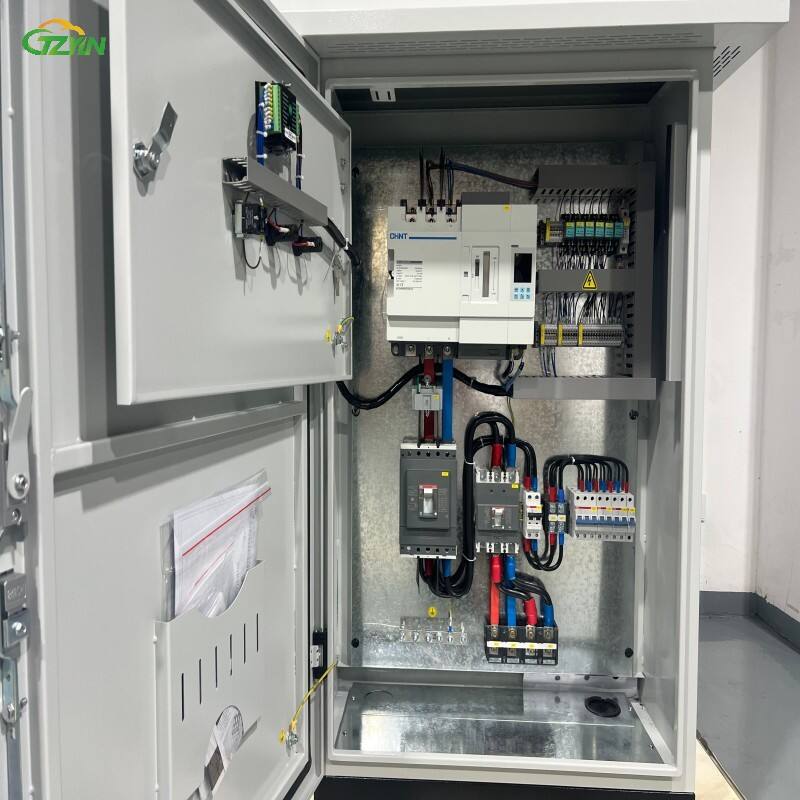Core Functionality of Dual Power Switching Cabinets
Basic Operation in Power Source Transition
Dual power switching cabinets manage smooth transitions between primary and secondary power sources to ensure uninterrupted supply. They detect issues like power failures, voltage drops, or frequency changes and switch quickly based on preset thresholds. Automatic monitoring systems continuously assess power quality and control these transitions, enabling seamless operation of sensitive equipment without manual intervention.
Redundancy Through Parallel Power Paths
In electrical systems, redundancy uses parallel power paths to boost reliability and prevent failures. Dual power switching cabinets apply this by sharing loads across multiple sources, reducing the chance of overloading one component. If one power path fails, others maintain the load, preserving system integrity. Experts report that redundancy can increase reliability up to 99.999% in demanding environments, making it essential for businesses aiming to avoid costly outages.
Preventing Downtime During Grid Failures
Grid failures can have devastating impacts on businesses, leading to substantial financial losses. Historical outages highlight these risks, with some incidents costing millions in damages. Dual power switching cabinets act as fail-safe mechanisms to ensure continuous operation during grid failures. By providing alternate power supply pathways, these cabinets prevent downtime and maintain operational continuity. Industry leaders emphasize the importance of downtime prevention, noting that uninterrupted operations are crucial in industrial settings where time-critical processes are involved. Therefore, investing in dual power switching solutions is a strategic move for businesses aiming to safeguard against the unpredictable nature of power disruptions.
Role in N+1 Redundancy Architecture
Understanding N+1 vs 2N Redundancy Models
Understanding redundancy models is key to system reliability and efficiency. The N+1 model uses the necessary components plus one backup for fault tolerance, while the 2N model duplicates the entire system for full redundancy. Data centers and critical industries often prefer N+1 for its balance of cost and reliability, whereas 2N is chosen for mission-critical operations with zero downtime tolerance. Dual power switching cabinets play a vital role in these setups by enabling effective power management and distribution.
Load Balancing Across Multiple Power Sources
Effective load balancing in dual power switching cabinets is vital for optimizing power distribution, especially during peak demand. It ensures even power flow across sources, preventing overloads. Poor load balancing can cause failures like the 2003 Northeast blackout. To reduce such risks, monitoring tools and software provide real-time data, enabling proactive load adjustments and maintaining system stability.
Case Study: Data Center Power Continuity
A data center that implemented dual power switching cabinets saw uptime improve to 99.99%, thanks to enhanced redundancy ensuring uninterrupted power. An industry report noted a 30% boost in operational efficiency and a strong return on investment within two years. Prior to this, frequent downtimes strained budgets and client trust. This case highlights how modern power management solutions like dual power cabinets significantly enhance data center performance and reliability.
Integration with Power Distribution Systems
Compatibility with Indoor Power Distribution Boxes
Ensuring compatibility between dual power switching cabinets and indoor power distribution boxes requires following specific standards. These standards ensure seamless integration and optimize overall power distribution efficiency. Key components like circuit breakers and switches must meet size and performance criteria. Certifications such as UL and IEC are vital, indicating that products meet strict safety and reliability requirements.
Outdoor Electrical Distribution Panel Applications
Outdoor electrical environments present unique challenges that dual power switching cabinets can effectively mitigate. These cabinets are designed to handle environmental factors such as extreme temperatures and moisture, ensuring stable performance. Their robust construction makes them suitable for integration with outdoor electrical distribution panels. Key features that support these applications include weather-resistant enclosures and advanced thermal management systems, allowing them to function optimally in harsh conditions. Case studies from sectors like utilities and telecommunications showcase the effectiveness of these cabinets, where their integration has led to improved operational efficiency and reduced downtime in outdoor settings.
Synchronization with Backup Generators
Dual power switching cabinets are crucial in synchronizing with backup generators, ensuring minimal transition time during power outages. They operate using protocols that enable smooth coordination between primary power sources and generators. Techniques such as volt-second synchronization algorithms are employed to manage this transition effectively, reducing potential disruptions. Performance metrics often show a significant decrease in downtime due to the precise implementation of these synchronization protocols. For example, industries that have adopted these protocols experience quicker recovery times and enhanced productivity, demonstrating the value of integrated power management solutions.
ATS Control Cabinets and Automatic Failover
Volt-Second Synchronization Algorithms
Volt-second synchronization algorithms are crucial in maintaining stable power quality within dual power switching cabinets. These algorithms ensure that voltage and frequency are correctly aligned during power transitions, effectively preventing disruptions. For example, in scenarios where synchronization challenges have caused power quality issues, modern algorithms adaptively realign the parameters to maintain consistency in power delivery. According to industry standards, such as the Institute of Electrical and Electronics Engineers (IEEE) standards, these algorithms have proven effective through rigorous testing and validation, ensuring reliability under various operational conditions.
CBEMA-Compliant Switching Mechanisms
CBEMA compliance in switching mechanisms is pivotal in upholding safety and reliability during power transitions. Dual power switching cabinets adhere to these regulatory standards by incorporating mechanisms designed to minimize risks, thereby reducing the likelihood of costly downtimes. Non-compliance can lead to significant financial penalties and increased operational risks, underlining the importance of standardized practices. Regulatory insights emphasize best practices such as incorporating advanced detection technologies to ensure seamless and safe transitions between power sources, safeguarding both infrastructure and investments.
Mains-to-Generator Transition Protocols
Seamless transition protocols from mains power to generator power are vital for consistent operations, particularly during unexpected outages. Dual power switching cabinets address challenges inherent in this transition through engineered solutions that include advanced automatic failover systems. These solutions have been field-tested in various industries, where testimonials reveal their efficacy in maintaining uninterrupted power supply. Case studies highlight successful implementations where businesses have minimized downtime and optimized operations through reliable mains-to-generator transitions, reinforcing the practicality and necessity of such systems in contemporary power management.
System Monitoring and Maintenance Best Practices
Real-Time Load Monitoring Techniques
Real-time load monitoring techniques play a crucial role in assessing load conditions within dual power switching cabinets. These techniques include the use of sensors and software that track and analyze load distribution constantly. The integration of IoT tools and remote monitoring systems has revolutionized this process, allowing for continuous tracking, alert generation, and data analytics to ensure consistent performance. For instance, businesses have improved operational efficiency by leveraging IoT sensors that provide timely alerts when load thresholds are approached or exceeded, reducing downtime and operational risks. Moreover, case studies demonstrate how industries have successfully utilized these technologies to enhance performance and responsiveness, especially in critical environments.
Predictive Maintenance for Component Longevity
Predictive maintenance algorithms are essential for extending the lifespan of critical components in dual power systems. By utilizing AI-driven analytics, these algorithms analyze data patterns to forecast potential issues before they arise, resulting in significant improvements in system longevity and reliability. Tools that facilitate predictive maintenance include advanced sensors and machine learning platforms that continuously evaluate component conditions. Industry statistics highlight the cost-effectiveness of predictive maintenance strategies, showcasing impressive savings and ROI, with some organizations reporting up to a 20% increase in component lifespan and reduced maintenance-related expenses. Implementing these strategies has not only boosted efficiency but also optimized resource allocation, ensuring sustainable operation.
IR Scanning for Thermal Management
Thermal management is paramount in electrical systems to prevent overheating and ensure efficient operation. IR scanning emerges as a vital technique in identifying potential thermal failures before they occur. Through infrared technology, it detects heat anomalies within electrical components, thereby providing a proactive approach to thermal management. Several sensory technologies are available to enhance this process, including thermal cameras and advanced IR sensors, which offer precision in measuring temperature fluctuations. IR scanning technology is particularly beneficial in large-scale applications where maintaining consistent thermal conditions is critical. By implementing these technologies, companies can preemptively address thermal challenges, enhancing reliability and safety of electrical systems.
FAQ
What is the primary function of dual power switching cabinets?
Dual power switching cabinets manage smooth transitions between primary and secondary power sources to ensure an uninterrupted power supply by detecting power anomalies.
How do dual power switching cabinets prevent downtime during grid failures?
They act as fail-safe mechanisms by providing alternate power supply pathways, thereby maintaining operational continuity during grid failures.
What are the benefits of using N+1 redundancy models with dual power switching cabinets?
N+1 redundancy models are cost-effective and reliable for less critical operations, offering fault tolerance by incorporating backup components.
Why is compatibility with indoor power distribution boxes important?
Compatibility ensures seamless integration of components, optimizing the entire power distribution network's efficiency and reliability.
What role does real-time load monitoring play in power systems?
Real-time load monitoring assesses load conditions and facilitates consistent performance by tracking and analyzing load distribution constantly.
Table of Contents
- Core Functionality of Dual Power Switching Cabinets
- Role in N+1 Redundancy Architecture
- Integration with Power Distribution Systems
- ATS Control Cabinets and Automatic Failover
- System Monitoring and Maintenance Best Practices
-
FAQ
- What is the primary function of dual power switching cabinets?
- How do dual power switching cabinets prevent downtime during grid failures?
- What are the benefits of using N+1 redundancy models with dual power switching cabinets?
- Why is compatibility with indoor power distribution boxes important?
- What role does real-time load monitoring play in power systems?


